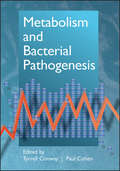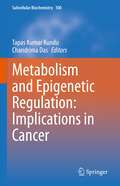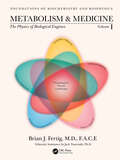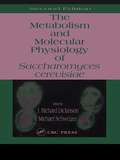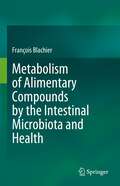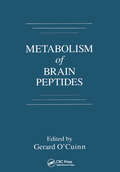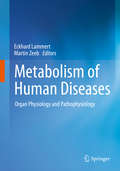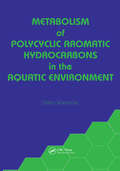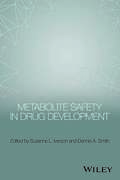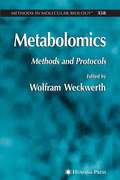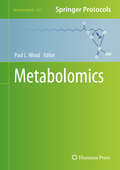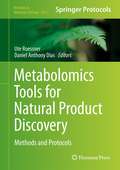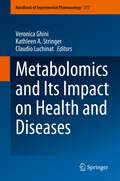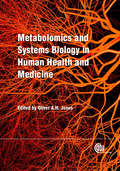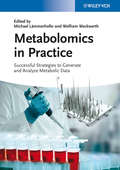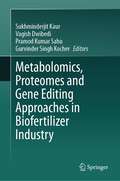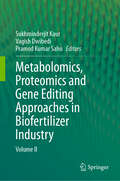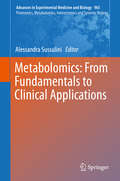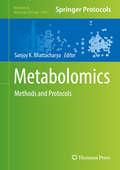- Table View
- List View
Metabolism and Bacterial Pathogenesis (ASM Books #47)
by Paul Cohen Tyrrell ConwayGroundbreaking thinking on how bacterial metabolism is foundational to pathogenesis For too long, bacterial metabolism and bacterial pathogenesis have been studied as separate entities. However, the scientific community is beginning to realize that not only are bacterial nutrient acquisition and utilization essential for pathogenesis, but that interfering with the pathogen-specific metabolic pathways used during infection can regulate virulence factor expression and might lead to effective breakthroughs in a variety of treatments. Editors Paul Cohen and Tyrrell Conway, who pioneered the use of metabolic mutants in competitive colonization assays, an approach now widely used to investigate the nutrition of pathogens in vivo, are uniquely qualified to advance our knowledge of this integrative field of research. They convened a group of contributors who are breaking new ground in understanding how bacterial metabolism is foundational to pathogenesis to share their expert perspectives and outlook for the future. Beginning with overviews, Metabolism and Bacterial Pathogenesis covers a wide range of diseases and both Gram-positive and -negative bacteria that serve as model systems for in vitro and in vivo investigations intracellular, respiratory, and enteric pathogens pathogen-specific nutrient acquisition in hosts mechanisms of host-driven metabolic adaptation by pathogens metabolic regulation of virulence gene expression Useful for specialists in bacterial pathogenesis and specialists in metabolism as well as molecular biologists, physicians, veterinarians, dentists, graduate and undergraduate students, and laboratory technicians, Metabolism and Bacterial Pathogenesis is also essential reading for scientists studying the microbiome.
Metabolism and Epigenetic Regulation: Implications in Cancer (Subcellular Biochemistry #100)
by Tapas Kumar Kundu Chandrima DasMetabolic programs of individuals are key determinants for disease susceptibility and immune response. This book, edited by experts in the field, summarizes epigenetic signaling pathways that regulate metabolic programs associated with cancer and cancer-related secondary diseases.The first part of the book highlights key metabolic pathways that are implicated in cancer and provides a comprehensive overview on the carbohydrate, protein, lipid, amino- and nucleic acid metabolic pathways that are deregulated in cancer. Special attention is paid to the altered tumor micro-environment that is influenced by the metabolic milieu. Furthermore, the fundamental relationship between the cellular metabolic environment and cell death-mediated autophagy is discussed.The second part of the book covers our understanding of the fundamental epigenetic regulations that are implicated in controlling the metabolic programs in cancer cells. Many aspects of epigenetic regulation of non-coding RNAs as well as DNA/RNA methylation, which influencing metabolic homeostasis in cancer, are discussed in detail. Special emphasis is placed on the epigenetic regulation of the amino acid, glucose/carbohydrate metabolism and epigenetic regulation during hypoxia and its connection to cancer.Last but not least, the third part of the book covers small molecule modulators of histone modifying enzymes, which can be used as therapeutic tools. The readers learn about the cross-talk between epigenetics and immunometabolims, as well as the epigenetic regulation of oncometabolites to combat cancer. Given its scope, the book will appeal to a broad readership interested in epigenetic, cancer and metabolic research.
Metabolism and Medicine: The Metabolic Landscape of Health and Disease (Volume 2) (Foundations of Biochemistry and Biophysics)
by Brian FertigChronic disease states of aging should be viewed through the prism of metabolism and biophysical processes at all levels of physiological organization present in the human body. This book connects these insights to what causes them to go awry in the context of unhealthy human behaviors and aging, aiming to buttress scientific creativity. It also provides links between the art and science of medicine that strengthens problem-solving in patient care. New and important discoveries in the area of metabolic health and metabolic diseases are discussed in exquisite detail. Key Features: Broad and up-to-date overview of the field of metabolic aspects of health and chronic disease development, especially connecting the spectrum of topics that range from molecular clocks to stress response to nuclear hormone receptors and the role of microbiota in human health Provides a deeper basic science and interdisciplinary understanding of biological systems that broaden the perspectives and therapeutic problem solving by elaborating on the usefulness of the Physiological Fitness Landscape Describes the importance of insulin resistance in metabolic disease, especially diabetes but also includes links to cancer and Alzheimer’s disease Examines the process of aging from the perspective of metabolic decline illustrating it with the Physiological Fitness Landscape This book, the second volume in a two-volume set, primarily targets an audience of clinical and science students, biomedical researchers and physicians who would benefit from understanding each other’s language.
Metabolism and Medicine: The Physics of Biological Engines (Volume 1) (Foundations of Biochemistry and Biophysics)
by Brian FertigChronic disease states of aging should be viewed through the prism of metabolism and biophysical processes at all levels of physiological organization present in the human body. This book describes the building blocks of understanding from a reasonable but not high-level technical language viewpoint, employing the perspective of a clinical physician. It brings together concepts from five specific branches of physics relevant to biology and medicine, namely, biophysics, classical electromagnetism, thermodynamics, systems biology and quantum mechanics. Key Features: Broad and up-to-date overview of the field of metabolism, especially connecting the spectrum of topics that range from modern physical underpinnings with cell biology to clinical practice. Provides a deeper basic science and interdisciplinary understanding of biological systems that broaden the perspectives and therapeutic problem solving. Introduces the concept of the Physiological Fitness Landscape, which is inspired by the physics of phase transitions This first volume in a two-volume set, primarily targets an audience of clinical and science students, biomedical researchers and physicians who would benefit from understanding each other’s language.
Metabolism and Molecular Physiology of Saccharomyces Cerevisiae
by J. Richard Dickinson Michael SchweizerSince the publication of the best-selling first edition, much has been discovered about Saccharomyces cerevisiae, the single-celled fungus commonly known as baker's yeast or brewer's yeast that is the basis for much of our understanding of the molecular and cellular biology of eukaryotes. This wealth of new research data demands our attention and r
Metabolism of Alimentary Compounds by the Intestinal Microbiota and Health
by François BlachierThis book provides an overview of the metabolism of dietary compounds by the intestinal microbiota, and on the consequences of such metabolic activity on host metabolism and physiological functions; both in intestinal and peripheral tissues.Over the last years, our understanding of the causal links between microbiota metabolic activity towards dietary and endogenous substrates and human health status has evolved extensively. In this context, the book starts with a comprehensive introduction devoted to the physiological and metabolic functions of the intestinal epithelium, followed by a part dedicated to the way intestine offers board and lodging for microbes being on a short- or long-term stay. The next chapters focus on the utilization of the available substrates from diet by the intestinal bacteria to produce numerous bacterial metabolites, and on the impact of such microbial activity, in the first place for communication between microbes, and for communication between microbes and lodging host. As will be detailed, this latter process of interkingdom communication leads to either beneficial or deleterious effects on intestinal physiology and metabolism. Special attention is given to selected pathophysiological processes namely chronic intestinal inflammation, colorectal carcinogenesis, and diarrhea. Then, the effects of modifications of bacterial metabolites and other bioactive compounds by the host after intestinal absorption, and consequences for peripheral tissue functions are presented.Summarizing the state of the art on what is known about the metabolic crosstalk between gut microbiota and human metabolism, as well as perspectives for further experimental and clinical research, this book provides a useful resource for researchers, professionals, and students with a background in biology, and/or nutrition, medicine, pharmacology, and for those which are involved in the agriculture and food production. By explaining technical terms all along the text, this book should be understandable also for interested non-specialists.
Metabolism of Brain Peptides
by Gerard O'CuinnMetabolism of Brain Peptides discusses neuropeptide metabolism in light of recent research. It describes the processing mechanisms in the production of biologically active peptides. It details distribution of the variety of neuropeptides in the brain and comprehensively reviews the effects of these neuropeptides on behavioral and physiological functions. The book also examines termination mechanisms for the biological activities of neuropeptides in light of recent knowledge of their distribution, their receptors and their possible inactivation enzymes in various functional regions of the brain and at the blood-brain barrier.
Metabolism of Human Diseases
by Eckhard Lammert Martin Zeeb"Metabolism of Human Diseases" examines the physiology of key organs (e. g. brain, eye, lung, heart, blood vessels, blood, immune system, gastrointestinal tract, pancreas, liver, fat tissue, kidney, reproductive system, teeth, bone and joints) and how defective metabolism and signaling pathways within these organs contribute to common human diseases. The latter include depression, schizophrenia, epilepsy, Parkinson's disease, Alzheimer's disease, migraine, multiple sclerosis, Down syndrome, macular degeneration, glaucoma, asthma, COPD, pneumonia, atherosclerotic heart disease, heart failure, stroke, varicose veins, Sickle cell disease, hyperlipidemia, fever, sepsis, allergies, peptic ulcer, gastroenteritis, lactose intolerance, colon cancer, diabetes, cirrhosis, metabolic syndrome, hypertension, chronic kidney disease, gout, urinary tract infections, kidney stones, dental caries, osteoporosis, osteoarthritis, rheumatoid arthritis, breast cancer and prostate cancer. The book also describes commonly used drugs and explains their molecular targets. It provides the first comprehensive and detailed summary of the metabolism of individual organs and their physiological and pathological functioning. Thus it serves as a useful supplement to previous textbooks of human physiology "Metabolism of Human Diseases" is a must-have, state-of-the-art textbook written by International experts for graduate students, postdocs and scientists in metabolic research, biochemistry, physiology and pharmacy as well as for physicians interested in molecular mechanisms underlying common human diseases.
Metabolism of Polycyclic Aromatic Hydrocarbons in the Aquatic Environment
by Usha VaranasiThis book shows how the biological transport, bioaccumulation, disposition, and toxicity of polycyclic aromatic hydrocarbons (PAH) in the aquatic environment are influenced by the ability or inability of organisms to metabolize these environmental pollutants. Written by leading scientists in the fields of PAH metabolism and toxicity in both aquatic and mammalian systems, this book discusses recent advances in the areas of PAH biogeochemistry and bioaccumulation, microbial degradation, enzymes of activation, and detoxication, metabolism of PAH, and laboratory and field studies on carcinogenic/toxic effects. Additionally, important similarities and differences in metabolism of PAH by aquatic and terrestrial organisms are featured. The discussion of bioavailability, metabolism, and subsequent toxic effects should aid in the assessment of the ecological consequences of PAH in the aquatic environment.
Metabolism: Making the Diagnosis, Investigation Notebook [Grade 6]
by The Lawrence Hall of ScienceNIMAC-sourced textbook
Metabolism: Making the Diagnosis, Investigation Notebook with Article Compilation
by The Lawrence Hall of ScienceNIMAC-sourced textbook
Metabolite Safety in Drug Development
by Dennis A. Smith Suzanne L. IversonA reference on drug metabolism and metabolite safety in the development phase, this book reviews the analytical techniques and experimental designs critical for metabolite studies. It features case studies of lessons learned and real world examples, along with regulatory perspectives from the US FDA and EMA.* Reviews the analytical techniques and experimental designs critical for metabolite studies* Covers methods including chirality, species differences, mass spectrometry, radiolabels, and in vitro / in vivo correlation* Discusses target pharmacology, in vitro systems aligned to toxicity tests, and drug-drug interactions* Includes perspectives from authors with firsthand involvement in industry and the study of drug metabolites, including viewpoints that have influenced regulatory guidelines
Metabolomics
by Wolfram WeckwerthMetabolomics: Methods and Protocols examines the state-of-the-art in metabolomic analysis. Leading researchers in the field present protocols for the application of complementary analytical methods, such as gas chromatography-mass spectrometry (GC-MS). Metabolomics: Methods and Protocols contains forward-looking protocols, which provide the essential groundwork for future efforts in elucidating the structure of the unknowns detected in metabolomic studies.
Metabolomics (Neuromethods #159)
by Paul L. WoodThis volume discusses the latest analytical approaches used to sample defined molecular populations of metabolites via functional group derivatization, specialized chromatographic methods, and ionization techniques. Chapters cover key methods for sample introductions to the ion source, including direct flow, gas chromatography, liquid chromatography, and capillary electrophoresis. Chapters also explore non-targeted and targeted analyses, as well as the emerging field of metallomics. In the Neuromethods series style, chapters include the kind of detail and key advice from the specialists needed to get successful results in your laboratory. Cutting-edge and authoritative, Metabolomics is a valuable resource for students, researchers, practicing physicians and veterinarians, and administrators involved in the funding of research.
Metabolomics Tools for Natural Product Discovery: Methods and Protocols
by Daniel Anthony Dias Ute RoessnerClassical natural product chemistry is transitioning to modern day metabolomics as a result of the advent of comprehensive analytical platforms and sensitive analytical instrumentation. Therefore, it is worthwhile to summarize recent developments with current analytical platforms and highlight how metabolomics is being integrated into this classical field to dereplicate and profile natural product extracts. Metabolomics Tools for Natural Product Discoveries: Methods and Protocols aims to unite diverse and recently developed methodologies and protocols in order to identify bioactive secondary metabolites for the purpose of drug discovery. Some topics covered in this volume include applications for the extraction of selected natural products from less common sources such as bryophytes and hard corals, various biological assays, comprehensive applications and strategies for GC-MS, LC-MS, and NMR, as well as protocols and strategies for the structure elucidation of isolated natural products. Written in the successful Methods in Molecular Biology series format, chapters include introductions to their respective topics, lists of the necessary materials and reagents, step-by-step, readily reproducible protocols, and notes on troubleshooting and avoiding known pitfalls. Authoritative and easily accessible Metabolomics Tools for Natural Product Discoveries: Methods and Protocols seeks to serve both professionals and research students with its well-honed methodologies for natural product isolation, biomarker discovery, dereplication, biological assays, and comprehensive metabolomic platforms available for high-throughput analyses.
Metabolomics and Its Impact on Health and Diseases (Handbook of Experimental Pharmacology #277)
by Veronica Ghini Kathleen A. Stringer Claudio LuchinatThis volume of the Handbook of Experimental Pharmacology, which celebrated its 100th anniversary in 2019, addresses the rapidly growing and evolving field of metabolomics. It has been compiled and designed to broaden and enrich your understanding as well as simplify a complicated picture of the diverse field of metabolomics. This is accomplished by chapters from experts in the field on basic principles as well as reviews and updates of analytical techniques. The variety and different perspectives of the NMR approaches are described in the chapters By David Wishart, Daniel Raftery and Ryan McKay, while mass spectrometry advances are covered by Charles R. Evans and Stefan Kempa. This book also reflects the state of the art in the application of metabolomics to cell biology (Marta Cascante and Ulrich Guenther) and chapters that share insights into the application of metabolomics in various diseases (Paola Turano and Claudio Luchinat, Rachel S. Kelly and Jessica Lasky-Su, Paige Lacy, and Angela Rogers. Relationships of metabolomics with drugs are highlighted by Robert Verpoorte (natural products drug discovery), by Oscar Millet and by Turano and Luchinat (perspectives in precision medicine) and by Daniel L. Hertz (drug-induced peripheral neuropathy). From the above list of diverse topics, we believe this book has interdisciplinary appeal and scholars with an interest in the role of metabolomics in achieving precision medicine will find it of particular or special interest.
Metabolomics and Systems Biology in Human Health and Medicine
by Luigi Atzori Lee Roberts Julian Griffin Jonathan Swann Reza Salek Daniel Dias Oliver Jones Jacqueline Wood Mahon Maguire Aalim Welji Baljit UbhiThe metabolomics and systems biology approach to research can be applied to many disciplines. This book provides a solid introduction to medical metabolomics and systems biology, and demonstrates how they have been applied to studies in medicine and human health, including nutrition and pathogenic microorganisms. Following core themes of diagnosis, pathology and aetiology of disease, this book provides a reference for health care professionals interested in how to use metabolomics for medical research.
Metabolomics and Systems Biology in Human Health and Medicine
by Luigi Atzori Lee Roberts Julian Griffin Jonathan Swann Reza Salek Daniel Dias Jacqueline Wood Mahon Maguire Aalim Welji Baljit UbhiThe metabolomics and systems biology approach to research can be applied to many disciplines. This book provides a solid introduction to medical metabolomics and systems biology, and demonstrates how they have been applied to studies in medicine and human health, including nutrition and pathogenic microorganisms. Following core themes of diagnosis, pathology and aetiology of disease, this book provides a reference for health care professionals interested in how to use metabolomics for medical research.
Metabolomics in Practice
by Wolfram Weckwerth Michael LämmerhoferUnlike other handbooks in this emerging field, this guide focuses on the challenges and critical parameters in running a metabolomics study, including such often-neglected issues as sample preparation, choice of separation and detection method, recording and evaluating data as well as method validation. By systematically covering the entire workflow, from sample preparation to data processing, the insight and advice offered here helps to clear the hurdles in setting up and running a successful analysis, resulting in high-quality data from every experiment.Based on more than a decade of practical experience in developing, optimizing and validating metabolomics approaches as a routine technology in the academic and industrial research laboratory, the lessons taught here are highly relevant for all systems-level approaches, whether in systems biology, biotechnology, toxicology or pharmaceutical sciences.From the Contents:* Sampling and Sample Preparation in Microbial Metabolomics* Tandem Mass Spectrometry Hyphenated with HPLC and UHPLC for Targeted Metabolomics* GC-MS, LC-MS, CE-MS and Ultrahigh Resolution MS (FTICR-MS) in Metabolomics * NMR-based metabolomics analysis* Potential of Microfluidics and Single Cell Analysis in Metabolomics * Data Processing in Metabolomics* Validation and Measurement Uncertainty in Metabolomic Studies* Metabolomics and its Role in the Study of Mammalian Systems and in Plant Sciences* Metabolomics in Biotechnology and Nutritional Metabolomicsand more.
Metabolomics, Proteomes and Gene Editing Approaches in Biofertilizer Industry
by Pramod Kumar Sahu Vagish Dwibedi Sukhminderjit Kaur Gurvinder Singh KocherThis edited book covers the major aspects of plant growth promoting bacteria and mechanisms underlining the phenotype in rhizobacteria. This book guides the researchers about the potential of plant growth promoting bacteria to be used as biofertilizers. The process of biofertilizer development and the process of testing its efficacy for commercial use and the potency is elaborated in this volume using suitable figures. The information in this book regarding the secretion of various secondary metabolites responsible for nutrient management is helpful for designing bioformulations that assist plant growth. This book provides substantial number of evidences that underlines the genomic basis of nutrient management by microbes. Essential information is provided regarding the genomic and proteomic background of the biofertilizers. The chapters in the book are divided into three sections. The first section of the book includes chapter 1-5 outlining the importance of rhizobacteria in elevating the nutrient levels in soil and augmenting the biotic and abiotic stress. Second section of the book includes chapter 6-11 elaborating the details about the biofertilizer, types of biofertilizer available and techniques involved in mass production of biofertilizers. Section third covers chapters from 12-15 providing the explicit information about metabolomics and proteomics basis of plant growth development. This collective work is distinct as it has focus on diverse emerging technologies which are high-throughput, scalable and applicable to different countries regardless of their socio-economic conditions. This book can improve the current state of knowledge and invoke researchers and innovators to take ahead the current inter-disciplinary knowledge into technologies that are readily available and effectively minimize hazards associated with chemical fertilizer.
Metabolomics, Proteomics and Gene Editing Approaches in Biofertilizer Industry: Volume II
by Pramod Kumar Sahu Vagish Dwibedi Sukhminderjit KaurBiofertilizer refers to the live or latent microbial inoculants capable of enhancing plant growth through direct and indirect mechanisms. This book covers strategies for harnessing the integrated technologies, omics, proteomics, and metabolomics for the development of potential novel biofertilizers. Modern techniques for enhancing the efficacy and quality of biofertilizers has been discussed in detail. Increasing crop productivity poses a great challenge due to increasing global population and researchers are looking for solutions to this using sustainable approaches. Biofertilizers play an imperative role in enhancing yield production in crops and this book covers detailed account of biofertilizers on a single platform. It also provides guidance on sustainable ways of increasing crop production and helps in generating ideas to formulate collaboration between public and private sectors for future innovation in the field of biofertilizers.This book is especially designed for the research graduates, young researchers and scholars who are directly involved in the research-related activities of the biofertilizers. It can also be useful to professors, lecturers, biotechnologists, biofertilizer production specialists and other stakeholders associated with strain improvement for biofertilizer development.
Metabolomics: From Fundamentals to Clinical Applications
by Alessandra SussuliniThis book provides a comprehensive view of metabolomics, from the basic concepts, through sample preparation and analytical methodologies, to data interpretation and applications in medicine. It is the first volume to cover metabolomics clinical applications while also emphasizing analytical and statistical features. Moreover, future trends and perspectives in clinical metabolomics are also presented. For researches already experienced in metabolomics, the book will be useful as an updated definitive reference. For beginners in the field and graduate students, the book will provide detailed information about concepts and experimental aspects in metabolomics, as well as examples and perspectives of applications of this strategy to clinical questions.
Metabolomics: Methods and Protocols (Methods in Molecular Biology #1996)
by Sanjoy K. BhattacharyaThe volume brings together some of the best experts in the field of modern metabolomics to discuss various techniques used today to study specific metabolite classes, and metabolomics in bacterial systems and mammalian systems. The chapters in this book cover topics such as Isotopic Ratio Outlier Analysis (IROA) for quantitative analysis; cholesterol and derivatives in ocular tissues using LC-MS/MS methods; microbial siderophores analysis by mass spectrometry; the metabolomic study of tissues in Parkinson’s Disease; and NMR analysis in livestock metabolomics. Written in the highly successful Methods in Molecular Biology series format, the chapters include introductions to their respective topics, lists of the necessary materials and reagents, step-by-step readily reproducible laboratory protocols, tips on troubleshooting and avoiding pitfalls.Cutting-edge and thorough, Metabolomics: Methods and Protocols is an essential resource for any researcher interested in this exciting and evolving field.
Metabolomics: Practical Guide to Design and Analysis (Chapman & Hall/CRC Computational Biology Series)
by Ron Wehrens and Reza SalekMetabolomics is the scientific study of the chemical processes in a living system, environment and nutrition. It is a relatively new omics science, but the potential applications are wide, including medicine, personalized medicine and intervention studies, food and nutrition, plants, agriculture and environmental science. The topics presented and discussed in this book are based on the European Molecular Biology Organization (EMBO) practical courses in metabolomics bioinformatics taught to those working in the field, from masters to postgraduate students, PhDs, postdoctoral and early PIs. The book covers the basics and fundamentals of data acquisition and analytical technologies, but the primary focus is data handling and data analysis. The mentioning and usage of a particular data analysis tool has been avoided; rather, the focus is on the concepts and principles of data processing and analysis. The material has been class-tested and includes lots of examples, computing and exercises. Key Features: Provides an overview of qualitative /quantitative methods in metabolomics Offers an introduction to the key concepts of metabolomics, including experimental design and technology Covers data handling, processing, analysis, data standards and sharing Contains lots of examples to illustrate the topics Includes contributions from some of the leading researchers in the field of metabolomics with extensive teaching experiences
Metabolomics: Recent Advances and Future Applications
by Vijay Soni Travis E. HartmanThis book Introduces the extensive applications of metabolomics from all possible areas of research and development so that not only an undergraduate can understand the advancement of metabolomics, but an entrepreneur can harness the knowledge to address possible problems to make a perfect tool to address their research question. Topics covered include the role of metabolomics in the development of agriculture, plant pathology, and their applications; the generalized application of the metabolomics and use of related technologies in various sectors of industries; and the future of metabolomics and upcoming related technologies that can fill the gap between different -omics and their applications for the betterment of humankind. This is an ideal book for university professors, researchers, and advanced-level scientists who are exploring different avenues in metabolomics. Availability of this concise information in one place will aid scientists by expanding their arsenal of techniques and can be helpful to bring more collaborations and to identify the expert at the global level.
